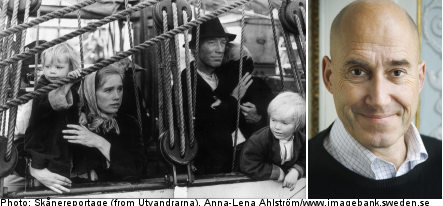There was a popular phrase in Sweden around 1930: “Every Swede has a cousin in America”. One fifth of all Swedes had emigrated to the US. Villages in the Swedish provinces of Småland and Hälsingland had literally been emptied when everyone left for the States.
During the 1920s, Stockholm was the only city in the world that contained more Swedes than Chicago. Many of the Swedes worked in the construction industry, and “Swedes built Chicago” was another phrase on people’s lips at the time.
Reminiscences from that period can be found at four Swedish museums in Philadelphia, Minneapolis, Chicago and Seattle, while many of the traditional Swedish-American organizations and clubs still honour the memory of the exodus of Swedes to the US.
And the bonds between Sweden and the US — though of a different nature — remain strong today.
Sweden has a good name in the US, even if some base their assessment on a view that Sweden is a producer of wonderful watches. Transforming and modernizing the image of Sweden is a difficult task.
Sweden also suffers from some political stereotypes. “Swedish socialism” was actually used as a criticism of Barack Obama’s policy platform during the presidential campaign.
Sweden was said to have “redistributive taxes”, a fact some observers seemed to equate with “socialism.” But what taxes are not in some way redistributive? Even most Republicans in the US accept progressive tax scales.
But maybe Sweden could play a more positive role in current US politics, warranting mention for more than its perceived deterrent effects.
Successful Swedish solutions to the banking crisis have been written about as a model that could also be applied to the US.
The mayor of Södertälje, a town south of Stockholm, attended a Congress hearing (and also met with Barack Obama) to speak about the integration of refugees from Iraq. Södertälje took in 1,268 Iraqis in 2007, whereas the US and Canada combined took in 1,027.
The new Swedish pension system is also referred to as an example of good practice.
The US has always been of huge importance to Sweden, particularly in terms of reputation and contacts. When the Swedish Institute was founded in 1945 by the Swedish government and the Swedish business community, its task was to restore Sweden’s image in the US after the period of neutrality during the Second World War, which saved Sweden from war but naturally gave Sweden a reputation of being a quitter.
Since that time, official Sweden – often through the Swedish Institute – has attempted to forge close ties with the US, often by providing exposure for Swedish culture in the US.
In New York alone, there are currently several exhibitions by contemporary Swedish artists. The Father of Strindberg is playing at a city theatre and Swedish pop artists regularly perform at famous New York venues.
The Swedish Institute exhibition, Virtual Voltage, which encourages visitors to reflect on energy consumption through art and design, is on its way to Washington, DC.
Thanks to House of Sweden, an embassy-cum-exhibition space on the banks of the Potomac, Sweden has a new opportunity to reach the most powerful opinion makers in the world: the Washington elite.
Formally, Sweden is represented in the US by the Embassy in Washington, DC, the Consulate Generals in New York and Los Angeles, and the 31 Honorary Consuls all over the US. Together they do a lot. But even more essential are all the Swedes who live in the US.
The US is a country that lacks comprehensive census records, but about 100,000 Swedish citizens are estimated to live there. Many are students and young people who arrive in the US and plan to stay a year. But often they end up staying there all their lives.
They are the foremost Swedish ambassadors.
Olle Wästberg, Director-General of the Swedish Institute



 Please whitelist us to continue reading.
Please whitelist us to continue reading.